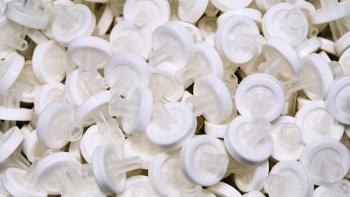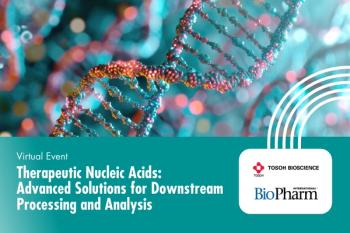
- BioPharm International-12-01-2015
- Volume 28
- Issue 12
Bespoke Bioprocessing Resins
BioPharm International sat down with Kevin Isett, PhD, co-founder and CEO of Avitide, to find out why he thinks the company’s tailored approach to purification resins will change the face of biopharmaceutical separation.
The lessons that Kevin Isett learned during his time at Adimab, a therapeutic antibody discovery technology company, were top of mind when Isett embarked on the development of a novel purification technology. Rather than making the product first and figuring out which markets to target, working at Adimab gave him the insight to understand the value of building a technology platform to address precise industry need. Despite the fact that the bioprocessing industry is conservative and highly regulated, according to Isett, Avitide was able to draw from community feedback to drive the development of its service offerings and capabilities.
Isett says that to find an appropriate recovery process for biotherapeutics-one that would produce a biopharmaceutical that could meet purity requirements for clinical and commercial production but also would not compromise process yield or development time-process engineers “were forced to screen hundreds of different resins and modalities.” Although Protein-A resins to purify Fc-containing molecules such as monoclonal antibodies (mAbs) are able to maintain high yield and purity levels, Isett notes that there is a hole in the market for a “Protein-A-like” solution for other types of large-molecule products. Thus, it became Avitide’s goal to develop affinity resins-suitable for any molecule-that could employ high-yield, high-purity capture steps within a reasonable process development timeframe. Isett adds that the company also sees significant value in being able to make affinity resins that can select for product quality attributes.
Avitide advertises that it can take a partner’s molecule and characterize the molecule’s affinity ligands, scale-up ligand production, develop a resin for the molecule, validate the resin performance, ensure technology transfer, and ship the resin to the company partner-all within a period of three months. BioPharm International spoke with Isett to learn more about why he thinks process technologies are positioned to improve therapeutic timelines, costs, and access and how Avitide’s technology will do for the separation of all types of large molecules what Protein A did for the downstream purification of antibodies.
BioPharm: For which types of biologics are there few (or no good) options for purification?
Isett: For monoclonal antibodies, Protein A is a true platform. We were not interested in developing another Protein A-like resin, as that need is technically well served by the life-science industry and well adopted by the biopharmaceutical manufacturing community.
Outside of monoclonal antibodies, there exist more than 350 vaccines, therapeutics, and gene therapies that are in development that do not have a high-performing affinity purification approach similar to the efficiencies realized through the purification of monoclonal antibodies by Protein A. Without a true affinity-based purification platform, the process efficiencies realized for the current mAbs will never materialize for other biological therapeutics and vaccines. This will then restrict global access for therapeutics and vaccines, and continue to exacerbate the high manufacturing costs, of which 50-80% reside in purification operations.
BioPharm: Will your resins be specifically useful for one or more type of biologic (i.e., antibody-drug conjugates, bispecific antibodies, etc.)?
Isett: Our goal was to develop resins for any protein-based therapeutic or vaccine. Oftentimes, our partners ask that we solve particularly difficult isoform separation problems. This type of separation is quite literally not solvable at scale with existing lower selectivity ion exchange, mixed mode, or hydrophobic interaction chromatography (HIC) resins. We have also been asked to develop affinity resins that recognize a conserved motif across multiple molecules, thus enabling a platform affinity purification solution for our partners. Again, the scope of the affinity resin and separation performance is entirely driven by our partners.
BioPharm:
How can purification be done in one or fewer steps? If you had to estimate, how many purification steps are typical for an antibody product? What about for other molecules?
Isett: Even though a resin can produce the required purity in a single chromatography step, regulators will always insist that more than one step be used in order to meet viral clearance (and other) requirements. For antibody products, it is typical for there to be two bind/elute chromatography steps along with a flow-through or membrane-chromatography step to meet final purity and viral clearance specifications. For a non-mAb process, four steps are the minimum seen today, with the norm being five or six steps. Our affinity-based platform can create a two-step, mAb-like process for challenging molecules.
BioPharm: How do Avitide’s resins work, and why can your ligands in particular bind to such a wide range of targets?
Isett: We have invested heavily in specific technologies and key areas of development that allow us to deliver high-performing, molecule-specific affinity resins in three months. We adapt our platform to discover novel solutions to a diverse array of molecules such as gene therapies, therapeutic enzymes, vaccines/virus-like particles, and bispecific antibodies. Our proprietary peptide-based affinity ligands are tailored to find biopharmaceutical molecular surface features that are relevant to bioseparation, are cost effective to manufacture, and are robust enough to withstand the rigors of bioprocessing.
BioPharm: What is the most challenging type of molecule for which to find a good binding ligand?
Isett: Frankly, we have yet to fail to find highly selective ligands and to convert those into efficient affinity resins regardless of molecule type. To date, Avitide has discovered affinity ligands and developed high performing affinity resins to a diverse array of biopharmaceutical molecules for capture, and for product isoform separations. That said, product isoform separations are the most challenging simply due to the fact that there is much less spatial area to find ligands adequate for separating each isoform.
BioPharm: How could Avitide’s platform help speed up biosimilar development in particular?
Isett: Outside of antibodies, our affinity resins can significantly reduce the cost of manufacturing, allow the choice of more cost-effective production hosts, shape the product profile by virtue of the affinity ligand’s selectivity, and avoid downstream manufacturing intellectual property (IP) that may exist from legacy products. In addition, the IP created with the Avitide’s resin solution extends past that of the drug product composition of matter patents.
BioPharm: Are Protein-A separation conditions somehow not gentle? Can you explain how this purification method could lead to product loss?
Isett: Protein A, which has benefitted from more than 20 years of incremental development, typically elutes antibodies in conditions below pH 3.5. Not all antibodies have the same inherent stabilities, and elution conditions invariably induce unwanted aggregation and product loss. In fact, in most antibody recovery processes, the two major contaminants post-Protein-A chromatography are aggregate antibody and leached Protein A.
In many cases for other molecules, low pH elution conditions may compromise the molecule’s structure and activity, and thus, need to be avoided completely. We specialize in producing affinity resins that benefit from soft elution conditions. This in turn enables affinity purification of molecules with narrow stability windows.
BioPharm: How many projects have you delivered to your partners?
Isett: Avitide has developed more than 100 novel affinity resins and delivered 16 resins for five partnered projects. Partner projects vary and may require different resins to be developed. While one campaign may have scope for one type of affinity resin, other campaigns may have expanded scope for additional selectivities or a larger survey of resin development space. We don’t expect our partners to find which affinity ligands and resin conditions will work best for their process. Instead, our partners clearly stipulate the performance criteria for the affinity resin to be developed, and then Avitide works to meet those performance specifications. We validate every affinity resin performance prior to shipment using our partners’ relevant bioprocess feed streams.
BioPharm:
For 2016, what are the company’s predictions for some of the bioprocessing trends that will gain traction?
Isett: For 2016, we will continue to see an increased need for downstream manufacturing technologies for novel biologics drug modalities, investment in exclusive manufacturing technologies in competitive disease and molecule areas, transition to platform ‘mAb-like’ manufacturing operations architecture for diverse non-antibody therapeutics and vaccines, and the practical implementation of continuous manufacturing processes for non-antibody therapeutics. These bioprocess trends relate to a larger biopharmaceutical industry movement to improve therapeutic and vaccine timelines, costs, and global access, which is largely defined by the process technologies employed.
Article DetailsBioPharm International
Vol. 29, No. 1
Pages: 38–40
Citation: When referring to this article, please cite it as R. Hernandez, "Bespoke Bioprocessing Resins," BioPharm International29 (1) 2016.
Articles in this issue
about 10 years ago
New Drugs and New Initiatives Shaped 2015about 10 years ago
CMO Investors Have More Money Than Places to Spend Itabout 10 years ago
Rapid Mycoplasma Testing: Meeting the Burden of Proofabout 10 years ago
N-Glycan Composition Profiling for Quality Testing of Biotherapeuticsabout 10 years ago
Greener Pastures in Biologics?about 10 years ago
GMP Challenges for Advanced Therapy Medicinal Productsabout 10 years ago
Moving Up the Biopharma Career LadderNewsletter
Stay at the forefront of biopharmaceutical innovation—subscribe to BioPharm International for expert insights on drug development, manufacturing, compliance, and more.




